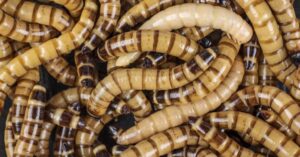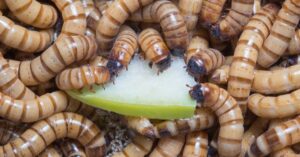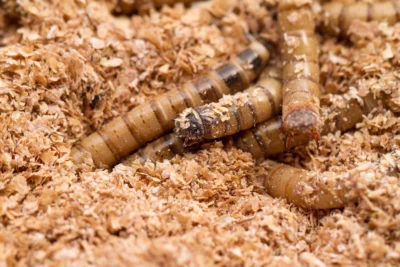Superworms are a popular and nutritious dietary choice for leopard geckos, providing a well-rounded source of essential nutrients to support their overall health. These elongated larvae, scientifically known as Zophobas morio, have gained prominence among reptile enthusiasts for their versatility and nutritional value.
In this guide, we will delve into the benefits of incorporating superworms into the diet of leopard geckos, exploring their nutritional content, feeding guidelines, and the positive impact they can have on the well-being of these captivating reptiles.
Let’s unravel the world of superworms for leopard geckos, uncovering the secrets to a balanced and enriching diet for your scaly companions.
What are superworms and why feed them to leopard geckos?

Superworms, also known as Zophobas morio, are the larvae of darkling beetles. They are commonly used as feeder insects for reptiles, including leopard geckos.
Here are some reasons why superworms are a popular choice for feeding leopard geckos:
- Nutritional Value: Superworms are rich in protein and fat, which are essential for the growth and maintenance of leopard geckos. They also contain other nutrients like vitamins and minerals that contribute to the overall health of the gecko.
- Size and Texture: Superworms are larger and more substantial than some other feeder insects, making them suitable for larger leopard geckos. The size and texture of superworms make them a more substantial meal, providing a good chewing exercise for the gecko and helping to wear down their teeth.
- Variety in Diet: Offering a variety of feeder insects is important for providing a well-rounded diet for leopard geckos. Superworms can be part of this variety, along with other insects like crickets, mealworms, and waxworms.
- Easy to Keep: Superworms are relatively easy to keep in captivity. They can be stored in a container with bedding material like oats or bran and don’t require elaborate care.
When feeding superworms to leopard geckos, it’s essential to ensure that the worms are appropriately sized for the gecko’s age and size. Additionally, it’s crucial to dust the superworms with a calcium supplement before offering them to the gecko to help prevent calcium deficiencies.
While superworms can be a healthy part of a leopard gecko’s diet, it’s essential to maintain a balanced and varied feeding routine. This can include a combination of insects and, in some cases, appropriately sized fruits or vegetables.
Always consult with a veterinarian or reptile nutrition expert for specific dietary recommendations based on the age, health, and individual needs of your leopard gecko.
How often should I give superworms to my leopard gecko?
Feeding frequency for leopard geckos can vary based on factors such as age, size, health, and individual metabolism. However, a general guideline for feeding superworms to a leopard gecko is about 2-3 times per week for adults and every day for younger, growing geckos.
Leopard geckos are insectivores, and superworms can be a part of their diet along with other insects like crickets, mealworms, and roaches. It’s essential to provide a varied diet to ensure your gecko gets a balanced nutritional intake.
Here are some additional tips for feeding superworms to your leopard gecko:
- Size Matters: Ensure that the superworms are an appropriate size for your gecko. The length of the superworm should not exceed the distance between the gecko’s eyes.
- Gut Loading: Feed the superworms with nutritious food before offering them to your gecko. This process, known as gut loading, enhances the nutritional content of the insects.
- Supplements: Dust the superworms with a calcium supplement (without vitamin D3) before feeding. You can also provide a vitamin supplement once or twice a month. Be sure not to over-supplement, as this can lead to health issues.
- Monitoring Weight: Keep an eye on your gecko’s weight. If your gecko is overweight, you may need to adjust the feeding frequency or the number of superworms given.
- Water: Always have a shallow dish of fresh water available for your leopard gecko. Proper hydration is crucial for their health.
Remember that individual leopard geckos may have different needs, so it’s essential to observe your pet and make adjustments based on their specific requirements. If you have concerns about your gecko’s diet or health, it’s advisable to consult with a reptile veterinarian for personalized advice.
What size superworms are suitable for juvenile geckos?
When feeding superworms to juvenile leopard geckos, it’s crucial to choose an appropriate size to ensure the safety and proper digestion of the insects. Ideally, the length of the superworms should be no longer than the space between the gecko’s eyes. Feeding appropriately sized prey helps prevent impaction issues and ensures that the gecko can easily consume and digest its food.
For juvenile leopard geckos, you can select superworms that are smaller in size, generally around half an inch to three-quarters of an inch (1.27 to 1.9 cm) in length. Always monitor your gecko while it’s eating to ensure it can consume the prey comfortably.
As your leopard gecko grows, you can gradually increase the size of the superworms to match the gecko’s increasing size and appetite. Remember to practice proper gut loading of the superworms with nutritious food before feeding them to your gecko, and consider dusting them with a calcium supplement (without vitamin D3) to ensure adequate nutrition.
In addition, providing a varied diet that includes other appropriately sized insects is also beneficial for the overall health of your juvenile leopard gecko.
Health risks linked to superworms for leopard geckos
While superworms can be a suitable part of a leopard gecko’s diet when fed in moderation and as part of a balanced, varied diet, there are potential health risks associated with them.
Here are some considerations:
- Chitin Content: Superworms have a tougher exoskeleton (chitin) compared to some other feeder insects. If fed exclusively or in large quantities, this can contribute to impaction issues, where the undigested chitin may accumulate in the digestive tract and cause blockages.
- Calcium to Phosphorus Ratio: Superworms have a lower calcium content compared to other feeder insects like crickets. Feeding a diet with an improper calcium to phosphorus ratio can lead to metabolic bone disease (MBD), a serious health condition in reptiles.
- Size Considerations: Superworms that are too large for the gecko to consume easily can pose a choking hazard or increase the risk of impaction.
- Aggressiveness: Superworms have strong jaws and can bite. While leopard geckos are generally able to handle superworms without issue, there is a slight risk of injury if the superworms are left unattended with the gecko.
How to gut-load superworms for optimal nutrition?

Gut-loading is the process of feeding nutrient-rich foods to feeder insects before offering them to your reptile. This ensures that the insects provide optimal nutrition to your pet.
Here’s a step-by-step guide on how to gut-load superworms for optimal nutrition:
- Select Nutrient-Rich Foods: Choose a variety of nutrient-rich foods to feed the superworms. Ideal gut-loading foods include fresh fruits, vegetables, and high-quality commercial insect gut-load diets. Some examples of suitable foods include dark leafy greens (e.g., kale, collard greens), carrots, sweet potatoes, apples, and commercial insect gut-load products.
- Create a Gut-Loading Container: Place the superworms in a separate container designated for gut-loading. Ensure that the container is escape-proof, well-ventilated, and easy for the superworms to crawl around in.
- Add Gut-Loading Foods: Place a layer of gut-loading foods at the bottom of the container. Cut or chop the fruits and vegetables into small, bite-sized pieces. You can also sprinkle commercial gut-load powder over the food.
- Moisture: Add a source of moisture to the container to keep the gut-loading foods fresh and to help hydrate the superworms. You can use a moistened sponge, slices of fruits with high water content, or a small water dish. Avoid making the environment too wet to prevent drowning the superworms.
- Allow Feeding Time: Leave the superworms in the gut-loading container for 12 to 24 hours, allowing them to consume the nutrient-rich foods. This time frame allows the superworms to ingest and digest the gut-loading foods, absorbing the essential nutrients.
- Remove Excess Moisture: After the gut-loading period, remove any uneaten gut-loading foods to prevent mold growth and excess moisture in the container.
- Dust with Supplements: Before feeding the superworms to your leopard gecko, dust them with a calcium supplement (without vitamin D3) to enhance their nutritional content. You can place the superworms in a plastic bag with a small amount of calcium powder and gently shake to coat them.
By following these steps, you can provide your leopard gecko with well-nourished superworms, contributing to a more balanced and nutritious diet. Remember to offer a variety of feeder insects and maintain proper supplementation to ensure your gecko’s overall health.
Signs of leopard gecko not tolerating superworms well
While leopard geckos generally tolerate superworms well, there are instances where an individual gecko may not respond positively to this feeder insect.
Here are some signs that your leopard gecko might not be tolerating superworms well:
- Regurgitation: If your gecko consistently regurgitates after consuming superworms, it may be a sign of digestive issues or discomfort. Regurgitation can occur if the superworms are too large, if there are problems with digestion, or if there are underlying health issues.
- Lethargy: If your gecko appears unusually lethargic or inactive after consuming superworms, it could indicate digestive discomfort or other health concerns.
- Constipation or Impaction: Difficulty defecating, visible straining, or a lack of fecal output may suggest constipation or impaction. This can occur if the chitin in the exoskeleton of superworms builds up in the digestive tract.
- Unexplained Weight Loss: If your gecko is losing weight despite a seemingly normal feeding routine, it could be a sign of an issue with the diet or overall health.
- Changes in Behavior: If you notice any sudden changes in behavior, such as increased aggression, hiding, or avoidance of food, it may be an indication that something is amiss.
If you observe any of these signs, it’s essential to take action promptly. Here’s what you can do:
- Adjust Feeding Size: Ensure that the superworms are an appropriate size for your gecko. If they are too large, consider offering smaller ones.
- Variety in Diet: Include a variety of feeder insects in your gecko’s diet, not relying solely on superworms. This helps provide a balanced nutritional profile.
- Consult a Veterinarian: If you’re concerned about your gecko’s health, it’s advisable to consult with a reptile veterinarian. A professional can assess your gecko’s condition, provide guidance on diet, and recommend any necessary veterinary care.
Remember that each leopard gecko is an individual with unique dietary preferences and health considerations. Monitoring your gecko’s behavior, adjusting the diet accordingly, and seeking veterinary advice when needed are crucial steps in ensuring your pet’s well-being.

Alternatives to superworms for gecko nutrition
Leopard geckos can benefit from a varied diet that includes a mix of different feeder insects. Here are some alternatives to superworms that you can include in your gecko’s nutrition:
- Crickets: Crickets are a staple in the diet of leopard geckos. They are readily available, come in various sizes, and are rich in protein. Dusting crickets with a calcium supplement before feeding is recommended.
- Mealworms: Mealworms are another commonly offered feeder insect. They are generally well-accepted by leopard geckos, but it’s essential to gut-load and dust them with calcium for nutritional balance.
- Dubia Roaches: Dubia roaches are a nutritious and excellent option for geckos. They have a favorable calcium to phosphorus ratio and provide essential nutrients. Roaches can be a bit more expensive and less readily available than crickets or mealworms.
- Phoenix Worms (Black Soldier Fly Larvae): These larvae are high in calcium and low in fat, making them a nutritious option for leopard geckos. They are available in various sizes and are suitable for gut-loading.
- Silkworms: Silkworms are a soft-bodied, nutritious option that is rich in protein. They are low in fat and can be a good addition to a varied diet.
- Hornworms: Hornworms are high in water content, making them an excellent choice for hydration. They are low in fat and can provide a different texture for your gecko.
- Waxworms (in moderation): Waxworms are high in fat and should be fed sparingly, but they can be used as an occasional treat or to entice a picky eater.
It’s crucial to offer a diverse range of feeder insects to ensure your leopard gecko receives a balanced diet. Additionally, supplementing their diet with a calcium supplement (without vitamin D3) and providing a vitamin supplement (occasionally) can help meet their nutritional needs.
Always ensure that the size of the prey is appropriate for the age and size of your gecko. If you’re introducing new foods or making significant changes to your gecko’s diet, do so gradually to allow for adjustment.
Best way to store superworms for geckos
Proper storage of superworms is essential to ensure they remain healthy and nutritious for your leopard gecko.
Here are some tips on the best way to store superworms:
- Container: Transfer the superworms from their original packaging into a well-ventilated plastic container. The container should be escape-proof to prevent the superworms from crawling out. You can use a container with smooth sides, as superworms are less likely to escape from smooth surfaces.
- Substrate: Line the bottom of the container with a suitable substrate to provide a comfortable environment for the superworms. Oat bran, wheat bran, or a mixture of both are commonly used substrates. The substrate also helps absorb excess moisture and provides some nutrition for the superworms.
- Temperature: Store the container of superworms at a temperature between 70°F and 80°F (21°C to 27°C). Avoid extremes in temperature, as superworms may become lethargic or die if exposed to very low or high temperatures.
- Darkness: Superworms are less active in the dark, so store the container in a dark or dimly lit area. This helps keep them calm and reduces stress.
- Avoid Refrigeration: Unlike mealworms, superworms should not be stored in the refrigerator. Refrigeration can harm superworms and reduce their nutritional value.
- Regular Checks: Periodically check the superworms for any signs of mold, foul odors, or dead individuals. Remove any spoiled or dead superworms promptly to maintain a clean and healthy environment.
- Gut-Loading: If you plan to store superworms for an extended period, continue gut-loading them with nutritious foods. This ensures that they retain their nutritional value when fed to your leopard gecko.
By following these storage tips, you can maintain a healthy and long-lasting supply of superworms for your leopard gecko. Remember to provide a varied diet for your gecko by incorporating different feeder insects and supplementing appropriately for balanced nutrition.
Conclusion
Superworms can be a valuable component of a leopard gecko’s diet, offering a good source of protein and nutrients. Superworms for leopard geckos are best used in moderation and as part of a varied diet that includes other feeder insects.
Proper gut-loading, dusting with supplements, and monitoring the gecko’s health are essential practices. Additionally, attention to the size of superworms, storage conditions, and overall husbandry contribute to ensuring a balanced and nutritious diet for leopard geckos.

